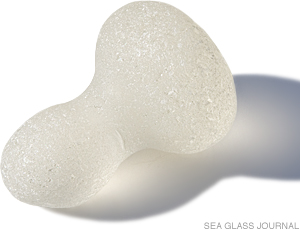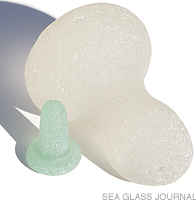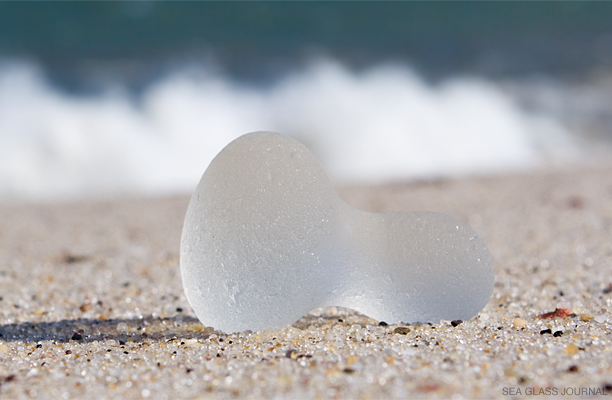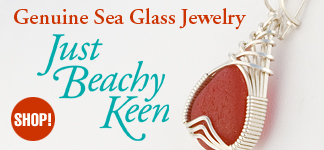The Sea Glass Shard of the Month: September 2015
A Large Sea Glass Stopper

Sea Glass Specifications:
Color: White
Max Length: 74.7 mm (2.94")
Max Width: 50.8 mm (2.00")
Max Thickness: 47.8 mm (1.88")
Weight: 193.9 grams (6.79 oz)
Estimated Age: Undetermined
This month's featured sea glass gem is an uncommonly large clear glass stopper found on the northern coast of England. The size and shape of this stopper suggests that it was used in a fancy wine or liquor decanter.
A stopper is designed to fit within the opening of a glass vessel, sealing and protecting the contents from contamination, spillage, evaporation etc. Material other than glass used to make stoppers included cork, porcelain, ceramic and glazed crockery. The use of stoppers as closures dates back to antiquity, with some glass types dating back as early as 1500 B.C.[1]

Here's a club sauce stopper commonly found on the beach compared to the decanter-sized sea glass stopper.
"The use of stoppers as closures dates back to antiquity, with some glass types dating back as early as 1500 B.C."
The most common sea glass stoppers found consisted of a simple head and shank design, used most often in apothecary or sauce bottles. Most of these types didn't vary much in size and were easily mass produced.
Glass stoppers of this type often had cork between the shank and the opening of the bottle to create a better seal without spending more time (and money) to create a tighter fit.
Stoppers used in wine and liquor decanters or perfume bottles were manufactured in a wider range of sizes and often were more ornate. These decorative stopper designs, like the featured sea glass specimen, consisted of three sections - the shank which fit inside the opening of the glass vessel; the finial, which is the top portion; and the neck, which was the transistion between the finial and shank.[2]
The shanks and openings of these fancier glass vessels usually were ground down after the initial manufacturing process to create a better fit. Sometimes, if we are talking about high-end glass vessels, the shanks and opening were then polished smooth after the grinding process. Due to the wear of our sea glass stopper, it is impossible to determine how much finishing the shank had gone through.
Because the transitional neck section was designed to be thinner than the shank and finial of these fancier stoppers, they often broke in two at that section resulting in either a sea glass neck or finial being found in the surf. To discover a stopper of this larger size and type on the beach makes it a truly special find.
REFERENCES:
1. Holscher, H. H. 1965. Hollow and Specialty Glass: Background and Challenge. The Glass Industry, Vol. 46, June-November, Toledo, OH.
2. www.sha.org/bottle/closures.htm

Keep up-to-date on all things sea glass... "Like Us" on Facebook!
Sea Glass Journal on Facebook






